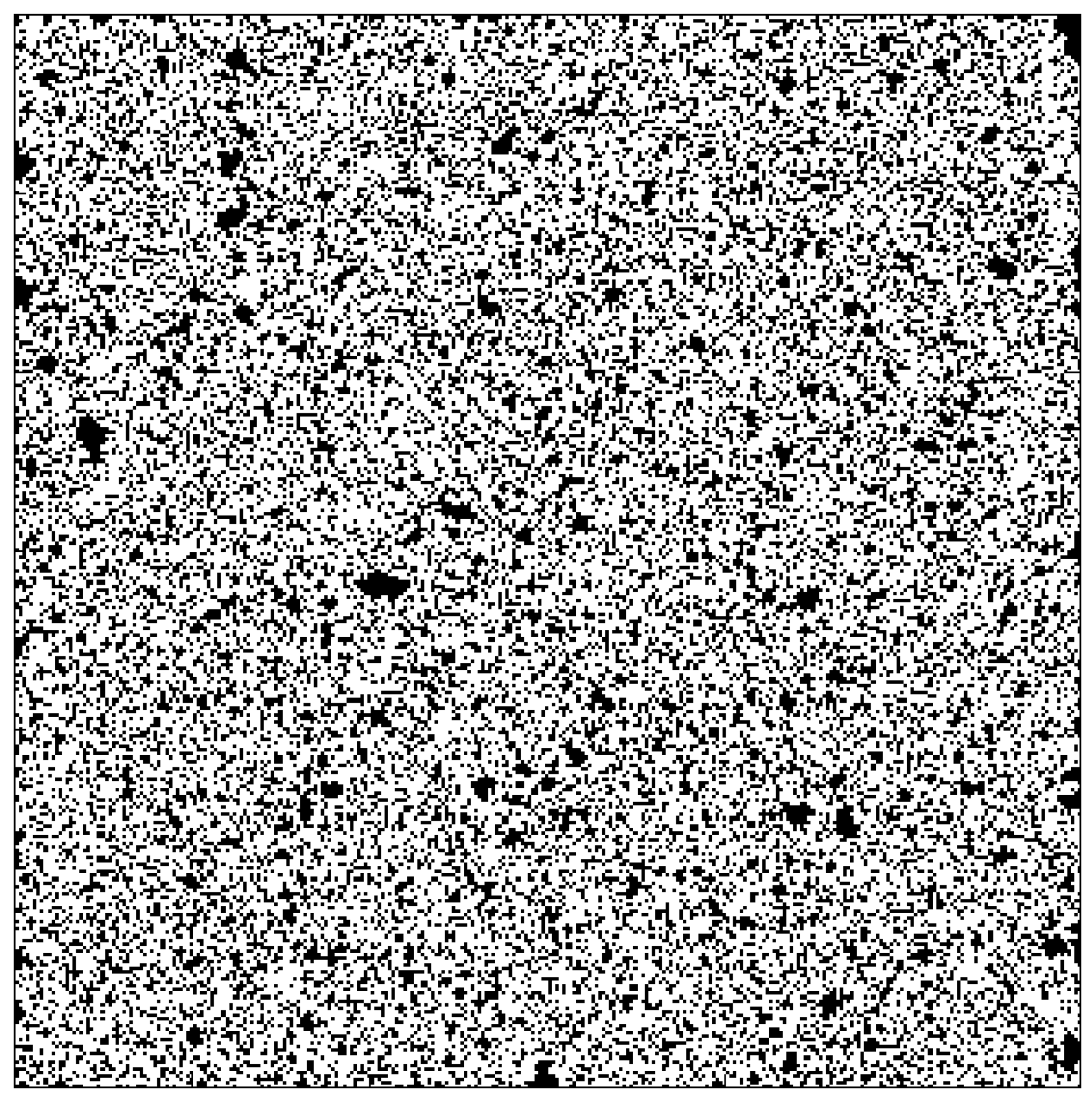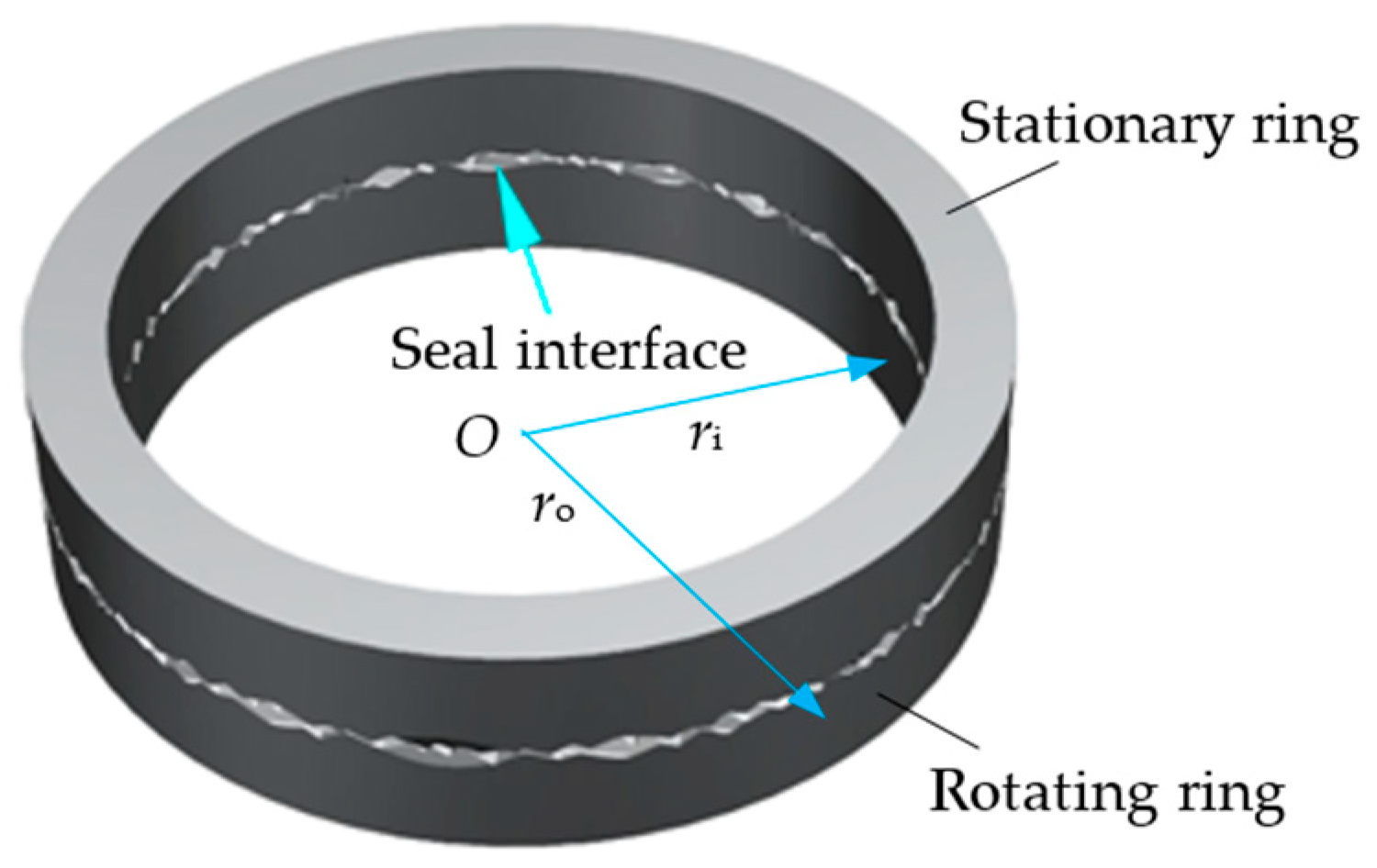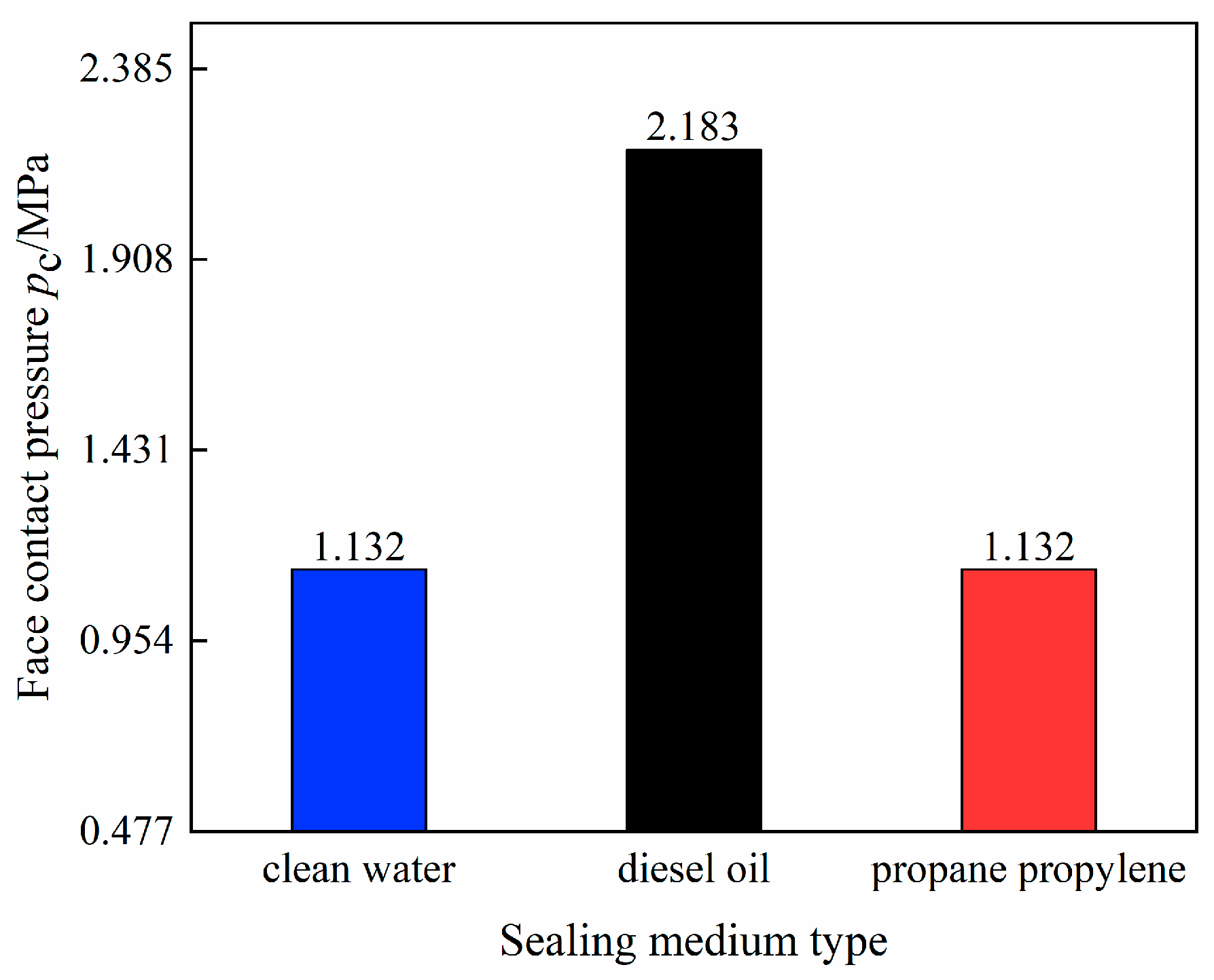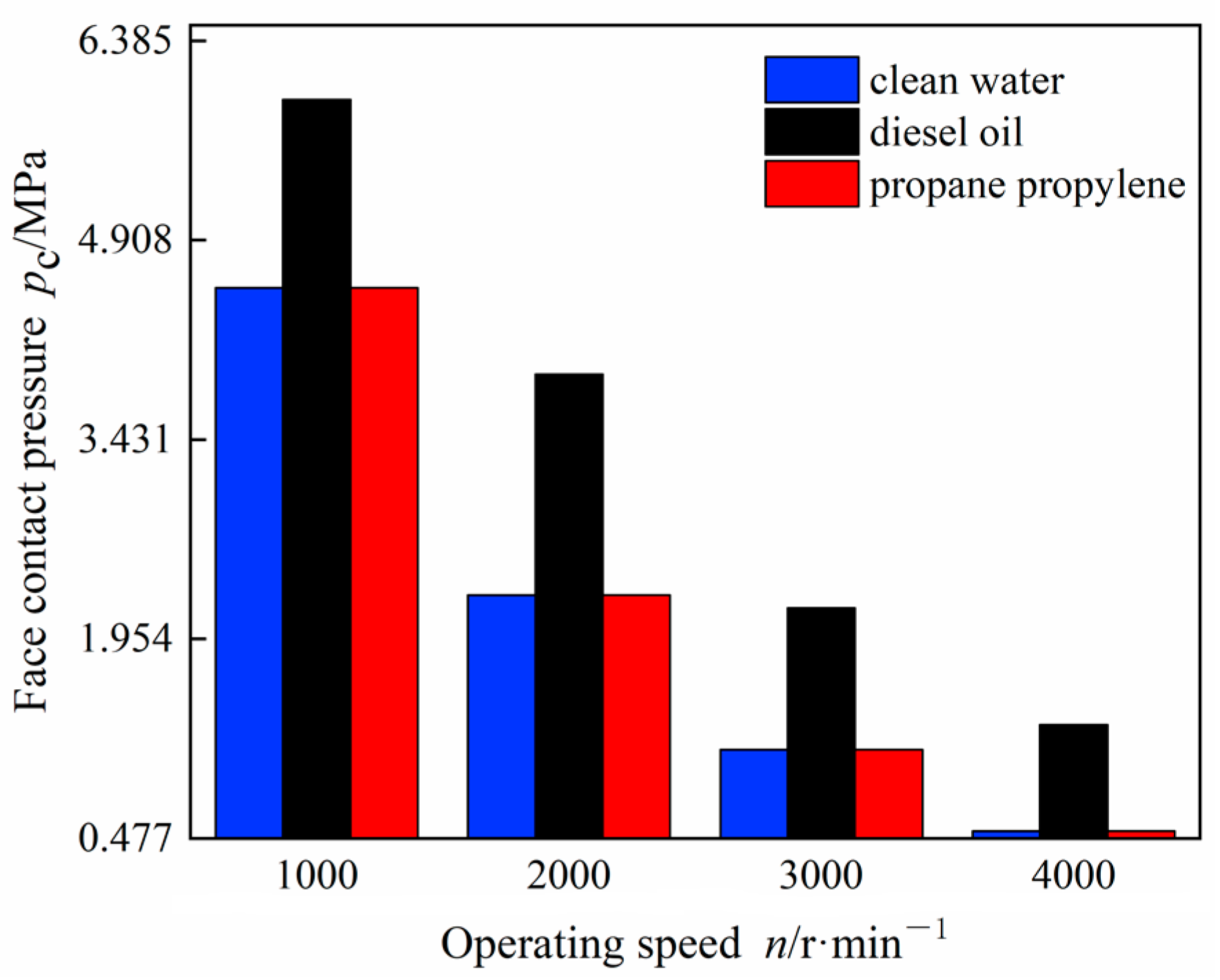The Theoretical Basis of Face Contact Pressure Design of the Zero-Leakage Mechanical Seal
Abstract
:1. Introduction
2. The Critical Porosity at Zero Leakage
3. Theoretical Analysis of Wear Rate of Sealing Interface
3.1. Calculation of the Sealing Interface Frictional Heat
3.2. Calculation of the Sealing Interface Temperature
- (1)
- Calculation of the sliding temperature rise with roughly equivalent surface roughness
- (2)
- Calculation of sliding temperature rise between rough surface and flat surfac.
3.3. Calculation of the Wear Rate of the Sealing Interface
4. Design Criteria for Face Contact Pressure
4.1. Design Criteria
4.2. Calculation Process
5. Calculation Example
5.1. The Face Contact Pressure Range of the Conventional Sealing Medium
5.2. The Influence of the Working Condition Parameters on the Face Contact Pressure Range
6. Conclusions
- The critical porosity in the case of zero-leakage at the sealing interface varies with the wettability of the sealed medium to the rotating and stationary ring materials. For the rotating and stationary ring that can be infiltrated by the sealing medium there should be no microchannels at the sealing interface, with a critical porosity of 0.312. On the contrary, for the rotating and stationary ring that cannot be infiltrated by the sealing medium, there may be microchannels on the sealing interface, and the critical porosity is when the percolation point size is equal to the critical diameter of the microchannel.
- The wear rate is related to the temperature increase of the end face and the contact properties of the asperity. The asperity on the sealing interface is generally in an elastic–plastic contact state. Its adhesive friction coefficient or wear rate can be characterized by the relationship between the friction coefficient or wear rate of elastic contact and plastic contact as well as the template function.
- A design criterion of the face contact pressure of zero-leakage mechanical seal is developed. The face contact pressure is well controlled, and the zero-leakage and long-life operation of the mechanical seal can be performed.
- This paper does not take into consideration the case where a leakage channel at the wettable seal interface exists while the zero-leakage of the mechanical seal can still be achieved, leaving this perspective an open discussion for future considerations.
Author Contributions
Funding
Institutional Review Board Statement
Informed Consent Statement
Data Availability Statement
Conflicts of Interest
Appendix A



References
- Hao, M. Mechanical Seal Technology and Application, 1st ed.; China Petrochemical Press: Beijing, China, 2010; pp. 12–31. [Google Scholar]
- Sun, J.J.; Ma, C.B.; Yu, Q.P.; Lu, J.H.; Zhou, M.; Zhou, P.Y. Numerical analysis on a new pump-out hydrodynamic mechanical seal. Tribol. Int. 2017, 106, 62–70. [Google Scholar]
- Du, P.Y.; Sheng, J.; Li, J. Analysis of factors affecting the specific pressure of mechanical seals. J. Beijing Inst. Petrochem. Technol. 2013, 21, 22–25. [Google Scholar]
- Sun, J.J.; Chen, G.Q.; Ji, Z.B.; Ma, C.B. Analysis of interface leakage mechanism of contact mechanical seal. CIESC J. 2018, 69, 282–290. [Google Scholar]
- Mayer, E. Mechanical Seals, 1st ed.; Chemical Industry Press: London, UK; Newnes-Butterworth: London, UK, 1997; pp. 21–43. [Google Scholar]
- Lebeck, A.O. Principles and Design of Mechanical Face Seals, 1st ed.; A Wiley-Interscience Publication; John Wiley & Sons, Inc.: New York, NY, USA, 1991; pp. 51–67. [Google Scholar]
- Gu, Y.Q. The selection principle of mechanical seal specific pressure. Petrochem. Equip. 2000, 29, 21–24. [Google Scholar]
- Gu, Y.Q. Calculation of the main coefficients of mechanical end face seals (2)-Mechanical parameters and performance parameters. Fluid Mach. 1996, 24, 28–32. [Google Scholar]
- Salant, R.F.; Cao, B. Unsteady analysis of a mechanical seal using Duhamel’s method. In Proceedings of the 2004 ASME/STLE International Joint Tribology Conference, Long Beach, CA, USA, 24–27 October 2004. [Google Scholar]
- Elhanafi, S.; Farhang, K. Leakage Prediction in Mechanical Seals Under Hydrostatic Operating Condition. In Proceedings of the 2007 ASME/STLE International Joint Tribology Conference, San Diego, CA, USA, 22–24 October 2007. [Google Scholar]
- Sun, J.J.; Gu, B.Q.; Wei, L. Leakage model of contact mechanical seal based on fractal theory. CIESC J. 2006, 57, 1626–1630. [Google Scholar]
- Li, X.P.; Yang, Z.M.; Wang, L.L.; Yang, Y. Leakage model of contact mechanical seal end face based on fractal theory. J. Northeast. Univ. (Nat. Sci. Ed.) 2019, 40, 73–77. [Google Scholar]
- Zhang, P.; Li, S.X.; Wang, L.; Cai, J. Research on the end-face leakage rate of contact mechanical seals based on fluid-solid coupling. Fluid Mach. 2017, 7, 17–21. [Google Scholar] [CrossRef]
- Lorenz, B.; Persson, B. Leak rate of seals: Effective-medium theory and comparison with experiment. Eur. Phys. J. E 2010, 31, 159–167. [Google Scholar] [CrossRef] [Green Version]
- Lorenz, B.; Persson, B. Leak rate of seals: Comparison of theory with experiment. EPL 2009, 86, 44006. [Google Scholar] [CrossRef] [Green Version]
- Sun, J.J.; Ma, C.B.; Lu, J.H.; Yu, Q.P. A leakage channel model for sealing interface of mechanical face seals based on percolation theory. Tribol. Int. 2018, 118, 108–119. [Google Scholar]
- Ji, Z.B. Research on Interface Leakage Mechanism of Contact Mechanical Seal Based on Percolation Theory. Ph.D. Thesis, Nanjing Forestry University, Nanjing, China, 2018. [Google Scholar]
- Lorenz, B.; Rodriguez, N.; Mangiagalli, P. Role of hydrophobicity on interfacial fluid flow: Theory and some applications. Eur. Phys. J. E 2014, 37, 1–14. [Google Scholar] [CrossRef] [PubMed]
- Yuan, T.; Chen, Z.; Liu, W.J. Application of capillary mechanics to separation process of superhydrophilic membrane and its mechanical model. J. South China Univ. Technol. (Nat. Sci. Ed.) 2014, 42, 82–89. [Google Scholar]
- Goilkar, S.S.; Hirani, H. Parametric study on balance ratio of mechanical face seal in steam environment. Tribol. Int. 2010, 43, 1180–1185. [Google Scholar] [CrossRef]
- Boylan, J. Increasing seal-face capability in hard-on-hard combinations. Seal. Technol. 2014, 7, 8–11. [Google Scholar] [CrossRef]
- Sun, J.J.; Ji, Z.B.; Ma, C.B. Reanalysis of the contact mechanics of rough surfaces. Chin. J. Theor. Appl. Mech. 2018, 50, 68–77. [Google Scholar]
- Onions, R.A.; Archard, J.F. The contact of surfaces having a random structure. J. Phys. D Appl. Phys. 1973, 6, 289–304. [Google Scholar] [CrossRef]
- Ni, X.Y.; Ma, C.B.; Sun, J.J.; Zhang, Y.Y.; Yu, Q.P. A Leakage Model of Contact Mechanical Seals Based on the Fractal Theory of Porous Medium. Coatings 2020, 11, 20. [Google Scholar] [CrossRef]
- Zhao, Y.W.; David, D.M.; Chang, L. An asperity microcontact model incorporating the transition from elastic deformation to fully plastic flow. ASME J. Tribol. 2000, 122, 86–93. [Google Scholar] [CrossRef]
- Carslaw, H.S.; Jeager, J.C. Conduction of Heat in Solids, 1st ed.; Oxford University Press: Oxford, UK, 1986; pp. 17–30. [Google Scholar]
- Bhushan, B.; Ge, S.R. Introduction to Tribology, 2nd ed.; China Machinery Industry Press: Beijing, China, 2006; pp. 62–75. [Google Scholar]
- Bhushan, B. Magnetic head-media interface temperatures-part 1: Analysis. ASME J. Trib. 1987, 109, 243–251. [Google Scholar] [CrossRef]
- Archard, J.F. Contact and Rubbing of Flat Surfaces. J. Appl. Phys. 1953, 24, 981–988. [Google Scholar] [CrossRef]
- Gu, Y.Q. The budget of mechanical seal wear rate. Petrochem. Equip. 1999, 28, 28–32. [Google Scholar]
- Lu, J.H. Research on the Leakage Fluid Flow Characteristics between the Contact Mechanical Seal Interface. Ph.D. Thesis, Nanjing Forestry University, Nanjing, China, 2018. [Google Scholar]
- Persson, B.N.; Albohr, O.; Creton, C.; Peveri, V. Contact area between a viscoelastic solid and a hard, randomly rough, substrate. J. Chem. Phys. 2004, 120, 8779–8793. [Google Scholar] [CrossRef] [PubMed] [Green Version]
- Gu, Y.Q. Practical Technology of Mechanical Seal, 1st ed.; China Machinery Industry Press: Beijing, China, 2001; pp. 25–36. [Google Scholar]
- Aharony, A.; Stauffer, D. Introduction to Percolation Theory, 3rd ed.; Taylor & Francis: Abingdon, Francis, 2003; pp. 18–23. [Google Scholar]







| Media Type | T/°C | ps/MPa | ρ/(kg·m−3) | cp/(J·(kg·K)−1) | K/(W·(m·K)−1) | μ/(pa·s) |
|---|---|---|---|---|---|---|
| Clean water | 37 | 1.275 | 993 | 4179 | 0.630 | 6.80 × 10−4 |
| Diesel fuel | 37 | 1.275 | 817 | 2130 | 0.218 | 4.55 × 10−3 |
| Propane Propylene | 37 | 1.275 | 473 | 2890 | 0.086 | 9.3 × 10−5 |
| Attribute Parameter | Hard Ring | Soft Ring |
|---|---|---|
| Material | SiC | M106K |
| Elastic Modulus E/GPa | 480 | 26 |
| Poisson’s ratio μ | 0.15 | 0.25 |
| Hardness Hs/MPa | 2.2 × 104 | 30 |
| End fractal dimension D | 1.65 | 1.57 |
| End face scale factor G/m | 1 × 10−9 | 5 × 10−9 |
| Maximum height of surface profile Ry | 0.28 | 2.13 |
| Inside diameter di/mm | 62 | 68 |
| Outer diameter do/mm | 82 | 79 |
| Density ρ/kg·m−3 | 3070 | 2400 |
| Specific heat capacity cp/J·(kg⋅K)−1 | 670 | 750 |
| Thermal Conductivity K/J·(m⋅K)−1 | 130 | 10 |
| Maximum use temperature T/°C | 1000 | 220 |
| Shear strength τc/MPa | 34 | 12.0 |
| Yield Strength σs/MPa | 2.1 × 104 | 100 |
Publisher’s Note: MDPI stays neutral with regard to jurisdictional claims in published maps and institutional affiliations. |
© 2022 by the authors. Licensee MDPI, Basel, Switzerland. This article is an open access article distributed under the terms and conditions of the Creative Commons Attribution (CC BY) license (https://creativecommons.org/licenses/by/4.0/).
Share and Cite
Zheng, W.; Sun, J.; Ma, C.; Yu, Q. The Theoretical Basis of Face Contact Pressure Design of the Zero-Leakage Mechanical Seal. Coatings 2022, 12, 536. https://doi.org/10.3390/coatings12040536
Zheng W, Sun J, Ma C, Yu Q. The Theoretical Basis of Face Contact Pressure Design of the Zero-Leakage Mechanical Seal. Coatings. 2022; 12(4):536. https://doi.org/10.3390/coatings12040536
Chicago/Turabian StyleZheng, Wei, Jianjun Sun, Chenbo Ma, and Qiuping Yu. 2022. "The Theoretical Basis of Face Contact Pressure Design of the Zero-Leakage Mechanical Seal" Coatings 12, no. 4: 536. https://doi.org/10.3390/coatings12040536
APA StyleZheng, W., Sun, J., Ma, C., & Yu, Q. (2022). The Theoretical Basis of Face Contact Pressure Design of the Zero-Leakage Mechanical Seal. Coatings, 12(4), 536. https://doi.org/10.3390/coatings12040536






